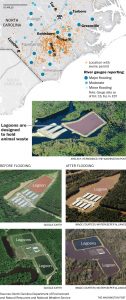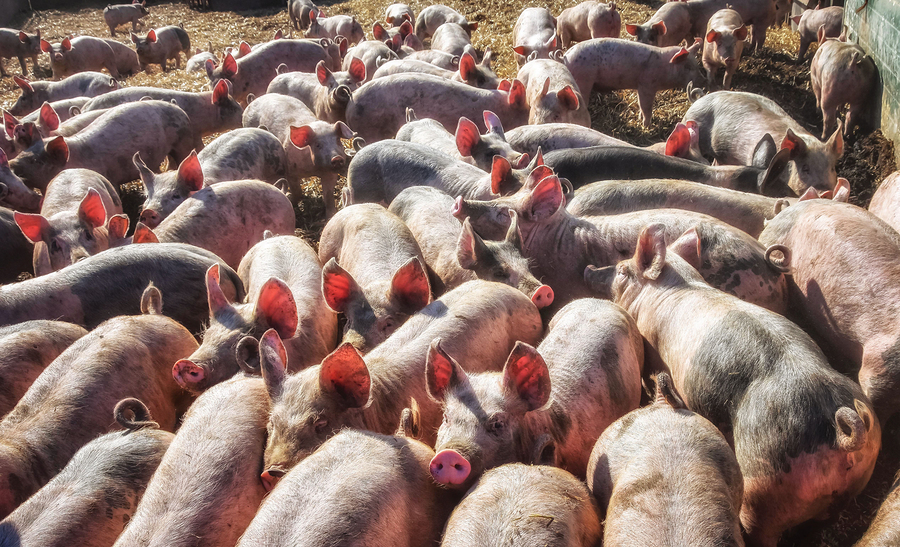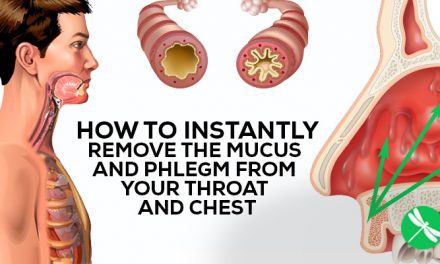Evaluating Factory Farming Practices After Floods
Thanks to factory farms (disgusting) and hurricane Matthew, a filthy brown sea of mud, debris, chemicals and ANIMAL WASTE, has overtaken miles of rural counties in North Carolina. As you’ll see in the pictures below from The Washington Post, against the mucky water are the shiny metal roofs of hog houses and their best friends- lagoons built to hold their liquid excrement.
 When there isn’t hurricane damage and the lagoons are working the way they are supposed to, berms and pumps keep that bacteria-laden liquid from spilling out. But this part of North Carolina is a coastal plain and home to one of the highest concentrations of hog farms in the country. For example, the world’s biggest hog-processing plant- Smithfield Foods- is located in the town of Tar Heel and slaughters 30,000 animals a day.
When there isn’t hurricane damage and the lagoons are working the way they are supposed to, berms and pumps keep that bacteria-laden liquid from spilling out. But this part of North Carolina is a coastal plain and home to one of the highest concentrations of hog farms in the country. For example, the world’s biggest hog-processing plant- Smithfield Foods- is located in the town of Tar Heel and slaughters 30,000 animals a day.
Imagine that amount of liquid (and potentially solid) waste mixing with the floodwaters and you’ve got trouble.
From the article:
“Hundreds of hog and poultry farms may have been inundated last week as the Neuse, Lumber and Tar rivers roared over their banks, a rampage powered by the deluge of Hurricane Matthew. The carcasses of several thousand drowned hogs and several million drowned chickens and turkeys were left behind. An incalculable amount of animal waste was carried toward the ocean. Along the way, it could be contaminating the groundwater for the many people who rely on wells in this part of the state, as well as threatening the delicate ecosystems of tidal estuaries and bays.
The extent of the damage will not be known until the North Carolina Department of Environmental Quality conducts tests in the coming weeks. But it has quickly renewed criticism of industry practices and state regulation, particularly of the state’s 2,100 hog farms.”
But The North Carolina Pork Council isn’t the least bit worried, reporting that there’d been zero waste pits breached and just 11 flooded. (Just 11.) Profits are more important than safety, you know. But they aren’t worried because state environmental officials learned their lesson from Hurricane Floyd in 1999. During that storm, “hog lagoons across the eastern part of North Carolina broke open and dumped tons of liquid and solid waste into the storm waters. That material flowed downstream, eventually settling in coastal estuaries. It was blamed for elevated nitrogen and phosphorous levels, algae blooms and fish kills.”
Travis Graves, an environmental scientist and member of the Waterkeepers Alliance, says that once the water recedes and more roads become passable, his agency will conduct in-person inspections. But until then, they’ve taken to the sky and given what they have seen, they are heartedly dismissing some officials’ explanations about the impact of the diluted waste; along the lower Neuse River alone, one inspector said he saw more than a dozen hog lagoons swamped.
But the lagoons aren’t the only concern of the Waterkeepers Alliance. Apparently, to lower the risk of a lagoon breach, some farmers may have sprayed their liquid waste onto surrounding fields. Yum. They likely wasted their time as well, research shows it’s spraying the waste is JUST as dangerous for our health. (I mean, duh. Come on, who honestly thought this would be ok?)
Proof from the article:
“One recent study of North Carolina’s waterways found that dangerous bacteria like E. coli and fecal coliforms were significantly higher in water both upstream and downstream from factory hog farms and that spraying “can lead to off-site migration of swine fecal wastes.” In regions where hog farm density is high, it concluded, there is an “overall poor sanitary quality of surface waters.”
It could take weeks to really assess the environmental consequences of Hurricane Matthew but one lesson to learn here is that these animal factories should not be where they are, which is in a flood plain. Or better yet, maybe they just shouldn’t exist at all.












